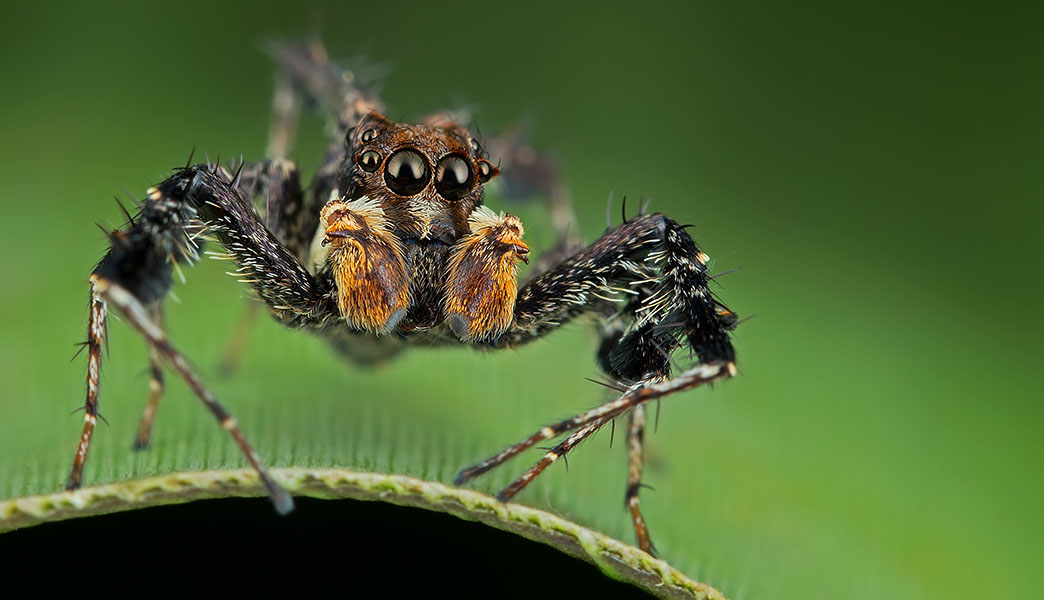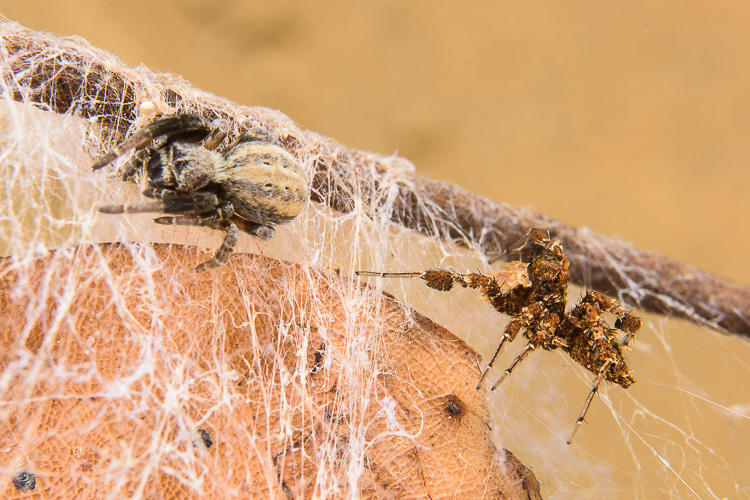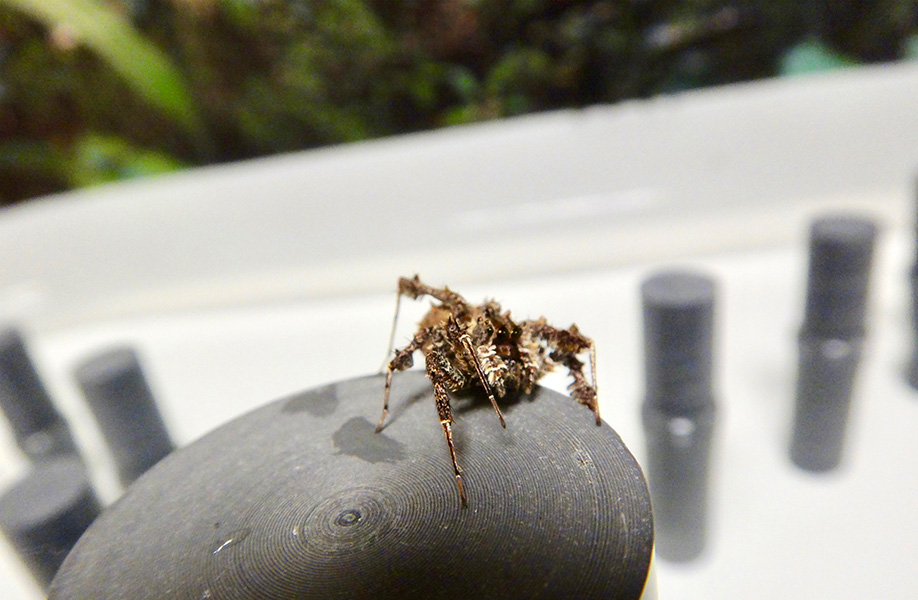Spiders are much smarter than you think
Cognition researchers are discovering surprising capabilities among a group of itsy-bitsy arachnids
Support sound science and smart stories
Help us make scientific knowledge accessible to all
Donate today
People tend to associate intelligence with brain size. And as a general guideline, this makes sense: more brain cells, more mental capabilities. Humans, and many of the other animals we’ve come to think of as unusually bright, such as chimpanzees and dolphins, all have large brains. And it’s long been assumed that the smallest brains simply don’t have the capacity to support complex mental processes. But what if they do?
The vast majority of Earth’s animal species are rather small, and a vanishingly small portion of them have been studied at all, much less by cognition researchers. But the profile of one group of diminutive animals is rapidly rising as scientists discover surprisingly sophisticated behaviors among them.
“There is this general idea that probably spiders are too small, that you need some kind of a critical mass of brain tissue to be able to perform complex behaviors,” says arachnologist and evolutionary biologist Dimitar Dimitrov of the University Museum of Bergen in Norway. “But I think spiders are one case where this general idea is challenged. Some small things are actually capable of doing very complex stuff.”
Behaviors that can be described as “cognitive,” as opposed to automatic responses, could be fairly common among spiders, says Dimitrov, coauthor of a study on spider diversity published in the 2021 Annual Review of Entomology. From orb weavers that adjust the way they build their webs based on the type of prey they are catching to ghost spiders that can learn to associate a reward with the smell of vanilla, there’s more going on in spider brains than they commonly get credit for.
“It’s not so much the size of the brain that matters, but what the animal can do with what it’s got,” says arachnologist Fiona Cross of the University of Canterbury in Christchurch, New Zealand.
Cross studies the behavior of jumping spiders, the undisputed champs of cognition among spiders. Although these tiny arachnids have brains that could literally fit on the head of a pin, the work of Cross and other scientists suggests that they have capabilities we’d have no problem hailing as signs of intelligence if exhibited by animals with much larger brains, like dogs or human toddlers.
“Jumping spiders are remarkably clever animals,” says visual ecologist Nathan Morehouse, who studies the spiders at the University of Cincinnati. “I always find it delightful when something like a humble jumping spider punctures our sense of biological superiority.”
One possible reason jumping spiders are so behaviorally advanced is that they have the sharpest vision known for animals their size, which is typically just 1 millimeter to 2.3 centimeters in length. They use this visual prowess to find, stalk and pounce on their prey, rather than the better-known spider strategy of building a web and waiting for a meal to arrive.
“Their vision has emancipated them, leading them to be able to explore an environment,” says animal behavior researcher Ximena Nelson, who also studies jumping spiders in her lab at the University of Canterbury. Being out and about in the world, they need to be able to see things — predators, prey, mates — from afar and make decisions before approaching them. “In my view, that’s what has led to their pretty remarkable cognition.”

Among jumping spiders, the most skilled hunters are members of the Portia genus. Spiders like this Portia fimbriata are known to plan out attacks on other spiders that involve long detours and strategies tailored to the prey’s species.
CREDIT: LEE HUA MING / SHUTTERSTOCK
Spiders play mind games
The jumping spiders shown to have the sharpest eyesight and the most impressive smarts belong to the genus Portia, found in Africa, Asia and Australia. These spiders prefer to hunt other spiders and have strategies tailored to each species they prey upon. Renowned University of Canterbury jumping spider researcher Robert Jackson has discovered that many of Portia’s tactics are quite devious.
When hunting another group of jumping spiders called Euryattus, Jackson reports, Portia employs a clever trick. Euryattus females build nests in curled-up dead leaves suspended in air by silk attached to rocks or vegetation. Courting males crawl down the silk suspension ropes, stand on top of the nest and shake it in a specific way. The signal draws the female out of the nest. Portia appears to take advantage of this system by mimicking the male’s shake and luring the female into an ambush.
For Portia, finding the right strategy is especially important when pursuing spiders that also eat jumping spiders. To attack a web-building spider, for example, Portia deceives the spider into moving closer by plucking some of the silk strands of its web. If the target spider is relatively small, Portia plucks the web to mimic a trapped insect, prompting the spider to rush over thinking it’s about to have a meal — only to become one instead. But if the resident spider is bigger and potentially more dangerous, Portia may instead create a gentle disturbance similar to a fruit fly contacting a single strand at the edge of the web that the spider will slowly wander over to inspect. As soon as the target is close enough, Portia pounces and strikes with venomous fangs.
If these strategies don’t work on a particular web spider, another of Portia’s tricks is to shake the whole web so it moves as if a gust of wind had hit it. This acts as a smokescreen for the vibration Portia makes as it crawls into the target spider’s web. In laboratory experiments, Jackson found that Portia will try different plucking methods, speeds and patterns until it finds just the right combination to fool each individual web spider it hunts — essentially learning on the job.
“Even amongst this surprisingly intelligent group, Portia stand out as being oddly brilliant,” Morehouse says. “They are, after all, hunting very dangerous prey, so caution and cleverness are useful tools.”

A Portia africana jumping spider, right, stalks a velvet spider. Jumping spiders are known to hunt web-building spiders by plucking at strands of the web to entice the target spider to come closer to investigate. When the web spider is in range, Portia pounces.
CREDIT: EMANUELE BIGGI / ANURA.IT
Spiders make plans
One of the most fascinating aspects of Portia’s hunting strategy is that it often involves spotting prey from a distance and then planning out an elaborate route to get to it. Jackson first observed this in the wild when Portia encountered a species of orb weaver that defends its web by violently shaking it, tossing any invading jumping spiders to the forest floor. Instead of entering the web, Portia navigated a roundabout path to find a better position from which to attack. “In that context, it was better for Portia to take the detour, go around the tree trunk, go up above the spider, go down on a line of silk, and swing in, grab the spider in its web without even touching the silk,” Cross says.
To find out how these itsy-bitsy spiders map out such complicated routes, Cross and Jackson put Portia’s mental abilities to the test in the laboratory. They built an apparatus with a central viewing tower on a platform, surrounded by water, from which a spider can see two other towers topped with boxes: one containing dead spiders that Portia likes to prey on, and one with dead leaves. The only way to reach the prey without getting wet, which jumping spiders loathe, is to climb down onto the platform and then choose the correct one of two separate walkways leading to the boxes.
From the perch atop the viewing tower, the spiders carefully surveyed the scene before descending the tower and climbing up a walkway. Most spiders chose the path that led to the meal, even if this meant moving away from the prey and passing the incorrect walkway on the way. Cross and Jackson argue that the spiders planned the route from the viewing tower and then followed it, possibly by forming a mental “representation” of the scene — an impressive cognitive feat for a brain barely bigger than a poppy seed.
In laboratory experiments, Portia spiders are able to execute planned detours to get to their prey. Portia starts out on the tower at the center of this apparatus with a view of two boxes, only one of which contains a potential meal. The spider must descend the tower to a platform surrounded by water and use the correct walkway to reach the prey.
Spiders can be surprised
In another test of the idea that Portia uses mental representation, Cross and Jackson borrowed a classic psychology experiment designed to assess the cognition of human infants. Since infants, like spiders, can’t tell you what’s on their mind, the idea is to deduce what they understand by seeing what surprises them. For example, a baby who sees a toy fire truck move behind the left side of a barrier, and then sees either the fire truck or a stuffed rabbit come out on the right side will tend to stare at the unexpected rabbit longer than the fire truck that emerged as expected. This suggests the baby had formed a mental representation of the fire truck and was baffled when the rabbit didn’t match it.
To see if they could surprise Portia, Cross and Jackson built a prey display for the spiders to view. First they would show Portia one type of prey for 30 seconds. Then they would close a shutter on the front of the display and swap out the prey before reopening the shutter 90 seconds later. If Portia first saw a dewdrop spider, but then saw an orb weaver, what would Portia do?
The scientists discovered that if Portia saw a different kind of prey after the shutter was lifted, it was far less likely to attack than if the prey remained the same. They assert that this shows that the spider formed a mental representation of the prey at the beginning of the trial that didn’t match what it saw at the end.
“This work uses really creative experimental designs and has inspired our own work,” says behavioral ecologist Elizabeth Jakob, who studies jumping spiders at the University of Massachusetts Amherst.
Spiders can count
Using a modification of their detour test, Cross and Jackson have explored other ways to surprise these spiders. “It’s like digging into Portia’s brain and saying, ‘Well, what are you paying attention to, Portia? What matters to you?’” Cross says.
This is how they discovered Portia is good with numbers. Using a species from Kenya, Portia africana, Cross and Jackson let Portia see a number of prey items from the viewing tower, and then switched up the number of prey items while the spider was en route and the target was out of sight. They found that if Portia had seen one prey spider from the tower but arrived to find two spiders, it was less inclined to carry out an attack. The same was true for one versus three prey items, and two versus three, and also when it encountered only one item after initially having been shown two or more. When tested with larger quantities, the spiders didn’t distinguish between three or higher, lumping them all into one category of “many.”
Although spiders can’t literally count one-two-three, the research suggests some jumping spiders have a sense of numbers roughly equivalent to that of 1-year-old humans.
Spiders assess risk
Being a tiny spider wandering about in the wild is risky business. Though they are known for their hunting abilities, jumping spiders have many predators themselves, including other spiders, ants, birds, lizards, toads and, horrifyingly, mud-dauber wasps that like to paralyze jumping spiders and seal them inside the cells of the wasps’ nest to be eaten alive by hatching larvae.
But these clever little spiders are skilled at getting out of dangerous situations, as Nelson found. Her lab at the University of Canterbury developed a test to see how good Portia is at assessing escape routes. Though they can swim, jumping spiders hate water, and for these experiments a spider started on a platform surrounded by a tray filled with water. It had four ways to get across the water to the edge of the tray that involved leaping between little islands made of wooden dowels sticking out of the water.

Portia assesses the riskiness of escape routes from a tower set in a tray of water, which the spider naturally avoids. To reach safety at the edge of the tray, the spider has to leap between dowels. The safest choice is the shortest route made of the fewest dowels, which requires the fewest jumps.
CREDIT: SAMUEL AGUILAR-ARGUELLO
Portia chose the safest route that covered the shortest distance and required the fewest jumps more often than chance would predict. But when they didn’t choose the safest way, the spiders unexpectedly seemed to prefer the longest route with the most dowels. It turns out Portia had simply outsmarted the test: The longest path was curved, and Portia often took shortcuts by skipping dowels. “Basically, they just cheated,” Nelson says.
The only catch is that it can take Portia quite a while to complete tasks like these — sometimes several hours — and usually much, much longer than other jumping spiders that Nelson tested, she says. Nelson found a clear relationship between the time a spider spent surveying the route and the likelihood of choosing a safe path. “Seeing is thinking, in my view,” she says. “Portia spent a lot more time looking at the route before making a decision.”
It’s a good bet that as scientists continue to study jumping spider cognition, these animals will keep surprising us with their mental abilities. And if other arachnid families received as much attention, who knows what else we’d learn is possible even for the tiny-brained.
Jumping spiders are not the biggest spiders, but they are probably able to perform the most complex behaviors among spiders, Dimitrov says. “So I think we still don’t really understand what is the threshold, how small is too small.”
10.1146/knowable-102821-1
TAKE A DEEPER DIVE | Explore Related Scholarly Articles




